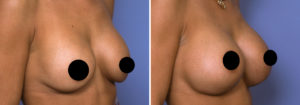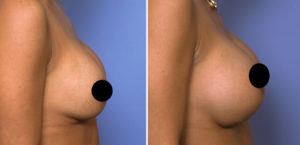Background: Much is written on the topic of primary breast augmentation including the management of preoperative breast sagging. This is classically treated with an implant with some form of breast lift. Little is written, however, on a very common phenomenon seen many years after a primary breast augmentation…the development of breast sagging that develops in some women.
After breast augmentation sagging occurs, not because the implant has changed, but because the breast tissue around it does. The three most common reasons this occurs is pregnancies, weight loss and aging. Pregnancy causes breast tissue expansion that when it shrinks back down after delivery there may be a mismatch between implant size and the amount of enveloping soft tissues. Weight loss causes a similar soft tissue overlay problem with loss of breast tissue but maintaining the same amount of skin. Aging can cause breast sagging on an implant if the initial ratio of breast tissue:implant volume is more tissue than implant. Gravity will eventually will create a breast tissue slide off of the implant over time as the tissue loses elasticity.
The management of breast sagging after implant augmentation can take two fundamentally different approaches depending upon the patient’s tolerance to either scars or increased breast size. If the current breast size is acceptable a breast lift can be performed keeping the same implant size. Conversely the breast implant size may be increased to pick up the loose tissue improving the tissue:implant ratio.
Case Study: This female had a prior history of 450cc saline breast implants placed eight years previously. After two pregnancies she developed a breast sag where the nipple was lower on the breast mound with loose surrounding skin. Her preference was to have a much larger implant size.
Under general anesthesia and through her existing inframammary incisions the existing saline implants removed and replaced with 650cc saline implants inflated to 750ccs. After inframammary incisional closure superior crescent nipple lifts were performed.

Case Highlights:
1) Breast sagging can occur after an initial augmentation due to pregnancies or weight loss as a result of excess breast tissue sliding off the implant.
2) The combination of a nipple lift and an increase in breast implant volume can recreate a satisfactory breast shape.
3) The superior areolar lift ensures that the nipple reattains a centric position on the breast mound.
Dr. Barry Eppley
Indianapolis, Indiana




